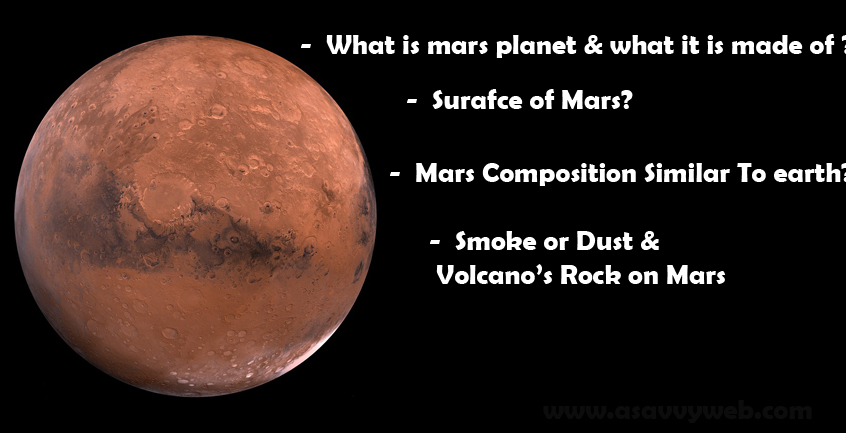How many planets are there in our Solar System
There are eight planets in the solar system and they are named as Mercury, Venus, Earth, Mars, Jupiter, Saturn, Uranus, and Neptune.
The inner solar system planets are Mercury, Venus, Earth, and Mars which fall under Terrestrial Planets.
The two planets Jupiter and Saturn are gas giants which means giant plants composed mostly of hydrogen and helium. Uranus and Neptune are the ice giants which means they are containing mainly elements substantial or heavier than hydrogen and helium. Pluto is considered as Dwarf planet.
What is Mars and What is Planet Mars Made of?
Mars is fourth planet from the sun and it is the second smallest planet in the solar system after Mercury and its also the final planet before the asteroid belt.
Mars is also known as the “Red Planet” and is given this name for a very good reason as its surface is made of thick layer of oxidized iron dust and rocks of the same red color, and if there is any other name given for this planet then that would be rusty as it has more ruddy surfaces but ruddy surfaces or shells or sides which does not tell us the entire story of Mars.
Mars Composition Similar To earth?
Mars is similar to the earth when it comes to the basic composition with a surface area only slightly less than the total area of Earth’s dry land and mars is less dense than the earth which is having only 15% of earth’s volume and 11% of Earth’s Mass and which also resulting in 38% of Earth’s surface gravity.
The central or core part of the planet contains of mainly sulphur and Iron which is surrounded by a layer consisting of silicates.
The layer of mars is covered with the layer (Mantle) and it is made of basalt and iron oxide which backs to its color red. Even though the central part of Mars has a substantial amount of iron it is solid and does not move like the Earth’s which is melted and always in motion.
Due to this heavy or solid composition scientist believe that mars diameter is of approximately 2960 km but does not create a magnetic field due to its solid composition.
As a outcome the planet is repeatedly exposed to significant radiation which may have destroyed probable life forms thousands of years ago.
Even though there are similarities between Mars and Earth there are major differences when compared to earth. While the core of Mars is Solid and it is completely having no apparent motion in longitude (Stationary), when comes to the core of Earth’s is molten and always moving.
Due to this constant motion on earth the core protects the planet from the solar radiation and since the core of the Mars never moves the planet lacks this protection.
Smoke or Dust And Volcano’s Rock on Mars
The surface of the mars is covered with dust and it is just fine like assumed to be like a talcum powder. Underneath the layer of dust, the Martian crust contains mostly of volcanic basalt rock.
Mars soil also has nutrients such as sodium, chloride, potassium and magnesium. The crust is about 30 miles (50 kilometers) thick.
Mars mostly consist of volcanic basalt rock and which is about 30 miles thick and it is a crust of Mars. This Volcanic basalt rock is covered by a fine layer of dust.
The surface of Mars absences or lacks tectonic plates and the crust is single piece. Though there are many volcanoes on Mars there have been no volcanic eruptions for millions of years.
There is no liquid water exists on Mars because the planet’s surface is too cold.
The typical temperature is -80 Fahrenheit even though different areas of the planet may experience many different temperature variations.

